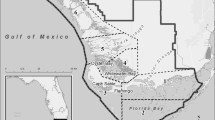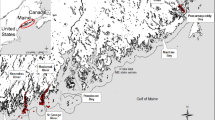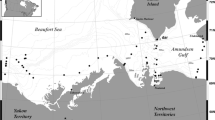Abstract
Shorthorn sculpin (Myoxocephalus scorpius) commonly occur in nearshore areas during open water periods in the Arctic, yet little is known about their feeding strategies or trophic roles. This study used carbon (δ13C) and nitrogen (δ15N) stable isotopes (SIs) and stomach content analysis (SCA) to assess shorthorn sculpin trophic position (TP), carbon sources, dietary specialization and prey selection, and the significance of polar cod (Boreogadus saida) in their diet across body size and multiple years. Sculpin TP increased with body size [range = 4.0 ± 0.1 (< 20 cm) to 4.6 ± 0.2 (> 25 cm)] and was consistent with SCA; smaller individuals fed predominantly on invertebrates while larger fed more on fishes. Shorthorn sculpin had high % reliance on pelagic resources (α) for a benthic fish, from 0.62 ± 0.05 to 0.63 ± 0.06, thus coupling benthic and pelagic sources. Dietary specialization based on SIs in liver and muscle occurred in all size groups, and along with TP and niche width varied between years, generally increasing with fish found in SCA. The presence of polar cod, absent two of the four study years, did not significantly affect any dietary metrics measured in shorthorn sculpin, and cannibalism appears to have had a greater impact on shorthorn sculpin trophic ecology. This study demonstrates that shorthorn sculpin are an important secondary to tertiary consumer in nearshore Arctic marine habitats due to coupling multiple trophic pathways, demonstrating plasticity in diet between years, and exploiting an array of prey across size ranges.




Similar content being viewed by others
References
Bolnick DI, Svanback R, Fordyce JA, Yang LH, Davis JM, Hulsey CD, Forister ML (2003) The ecology of individuals: incidence and implications of individual specialization. Am Nat 161:1–28
Brand M, Fischer P (2016) Species composition and abundance of the shallow water fish community of Kongsfjorden, Svalbard. Pol Biol. 39:2155–2167
Buchheister A, Latour RJ (2010) Turnover and fractionation of carbon and nitrogen stable isotopes in tissues of a migratory coastal predator, summer flounder (Paralichthys dentatus). Can J Fish Aquat Sci 67:445–461
Cardinale M (2000) Ontogenic diet shifts of bull-rout, Myoxocephalus scorpius (L), in the south-western Baltic Sea. J Appl Ichthyol 16:213–239
Caut S, Angulo E, Courchamp F (2009) Variation in discrimination factors (Δ15N and Δ13C): the effect of diet isotopic values and applications for diet reconstruction. J Appl Ecol 46:443–453
Ceia FR, Ramos JA (2015) Individual specialization in the foraging and feeding strategies of seabirds: a review. Mar Biol 162:1923–1938
Coad BW, Reist JD (2004) Annotated list of the Arctic marine fishes of Canada. Can MS Rep Fish Aquat Sci. 2674: 112 p
Costa A, Salvidio S, Posillico M, Matteucci G, De Cinti B, Romano A (2015) Generalization within specialization: inter-individual diet variation in the only specialized salamander in the world. Sci Rep 5:13260
Croxall J, Reid K, Prince P (1999) Diet, provisioning and productivity responses of marine predators to differences in availability of Antarctic krill. Mar Ecol Prog Ser 177:115–131
Cui X, Grebmeier JM, Cooper LW (2012) Feeding ecology of dominant groundfish in the northern Bering Sea. Polar Biol 35:1407–1419
Dick T, Chambers C, Gallagher CP (2009) Parasities, diet and stable isotopes of shorthorn sculpin (Myoxocephalus Scorpius) from Frobisher Bay, Canada. Parasite 16:297–304
Divoky G, Tremblay Y (2012) Shifting prey in a melting ocean: Seabirds reveal annual and seasonal changes in Arctic nearshore fish. Unpublished
Falk-Petersen S, Sargent JR, Kwasniewski S, Gulliksen B, Millar RM (2001) Lipids and fatty acids in Clione limacina and Limacina helicina in Svalbard waters and the Arctic Ocean: trophic implications. Polar Biol 24:163–170
Fedorov VV (1986) Cottidae. In: Whitehead PJP, Bauchot M-L, Hureau J-C, Nielsen J, Tortonese E (eds) Fishes of the North-eastern Atlantic and the Mediterranean, vol 3. UNESCO, Paris, pp 1243–1260
Finley KJ, Evans CR (1983) Summer diet of the bearded seal (Erignuthus burbutus) in the Canadian high Arctic. Arctic 36:82–89
Foote CJ, Brown GS (1998) Ecology relationship between freshwater sculpins (genus Cottus) and beach-spawning sockeye salmon (Oncorhynchus nerka) in Iliamna lake Alaska. Can J Fish Aquat Sci 55:1524–1533
Gray BP, Norcross BL, Beaudreau AH, Blanchard AL, Seitz AC (2017) Food habits of Arctic staghorn sculpin (Gymnocanthus tricuspis) and shorthorn sculpin (Myoxocephalus scorpius) in the northeastern Chukchi and western Beaufort Seas. Deep-Sea Res Part II—Topical Studies Oceanogr 135:111–123
Hobson KA, Ambrose WG (1995) Sources of primary production, benthic-pelagic coupling, and trophic relationships within the Northeast Water Polynya: insights from δ13C and δ15 N analysis. Mar Ecol Prog Ser 128:1–10
Hobson KA, Welch HE (1992) Determination of trophic relationships within a high Arctic marine food web using δ13C and δ15 N analysis. Mar Ecol Prog Ser 84:9–18
Hobson KA, Fisk AT, Karnovsky N, Holst M, Gagnon J, Fortier M (2002) A stable isotope (δ13C, δ15 N) model for the North Water food web: implications for evaluating trophodynamics and the flow of energy and contaminants. Deep Sea Res PT 2(49):5131–5150
Hop H, Ter HG (2013) Polar cod (Boreogadus saida) and capelin (Mallotus villosus) as key species in marine food webs of the Arctic and the Barents Sea. Mar Biol Res 9:878–895
Hückstädt LA, Koch PL, McDonald BI, Goebel ME, Crocker DE, Costa DP (2012) Stable isotope analyses reveal individual variability in the trophic ecology of a top marine predator, the southern elephant seal. Oecologia 169:395–406
Hussey NE, MacNeil MA, McMeans C, Olin JA, Dudley SFJ, Cliff G, Wintner SP, Fennessy ST, Fisk AT (2014) Rescaling the trophic structure of marine food webs. Ecol Let 17:239–250
Johannesen E, Høines ÅS, Dolgov AV, Fossheim M (2012) Demersal fish assemblages and spatial diversity patterns in the Arctic-Atlantic transition zone in the Barents Sea. PLoS ONE 7:34924
Kallgren EK, Pedersen T, Nilssen EM (2014) Food resource petitioning between three sympatric fish species in Porsangerfjord Norway. Polar Biol 38:583–589
Kessel ST, Hussey NE, Crawford RE, Yurkowski DJ, O’Neill CV, Fisk AT (2015) Distinct patterns of Polar cod (Boreogadus saida) presence and absence in a shallow high Arctic embayment, revealed across open-water and ice-covered periods through acoustic telemetry. Polar Biol 39(6):1057–1068
Kondoh M (2003) Foraging adaptation and the relationship between food-web complexity and stability. Science 299:1388–1391
Logan JM, Jardine TD, Miller TJ, Bunn SE, Cunjak RA, Lutcavage ME (2008) Lipid corrections in carbon and nitrogen stable isotope analyses: comparison of chemical extraction and modelling methods. J Anim Ecol 77:838–846
Luksenburg JA, Pederson J, Falk-Petersen IB (2004) Reproduction of the shorthorn sculpin Myoxocephalus scorpius in northern Norway. J Sea Res 51:157–166
MacNeil MA, McMeans MC, Hussey NE, Vescei P, Svavarrson J, Kovacs KM, Lydersen T, Treble MA, Skomal GB, Ramsey M, Fisk AT (2012) Biology of the Greenland Shark Somniosus microcephalus. J Fish Biol 80:991–1018
Matley JK, Fisk AT, Dick TA (2013) The foraging ecology of Polar cod (Boreogadus saida) during open water (July–August) in Allen Bay, Arctic Canada. Mar Biol 160:2993–3004
McCann KS, Rooney N (2009) The more food webs change, the more they stay the same. Philos Trans R Soc Lond B 364:1789–1801
McMeans B, Rooney N, Arts M, Fisk AT (2013) Food web structure of a coastal Arctic marine ecosystem and implications for stability. Mar Ecol Prog Ser 482:17–28
Mecklenburg CW, Moeller PR, Steinke D (2011) Biodiversity of arctic marine fishes: taxonomy and zoogeography. Mar Biodiversity 41:109–140
Moore IA, Moore JW (1974) Food of Shorthorn Sculpin, Myoxocephalus scorpius, in the Cumberland Sound Area of Baffin Islan. J Fish Res Board Can 31:355–359
Nadon MO, Himmelman JH (2010) The structure of subtidal food webs in the northern Gulf of St. Lawrence, Canada, as revealed by the analysis of stable isotopes. Aquat Living Res 23:167–176
Newsome SD, Tinker TM, Monson DH, Oftedal TO, Ralls K, Staedler MM, Fogel ML, Estes JA (2009) Using stable isotopes to investigate individual diet specialization in California sea otters (Enhydra lutris nereis). ESA 90:961–974
Osenberg CW, Mittlebach GG, Wainwright PC (1992) 2–Stage life histories in fish–the interaction between juvenile competition and adult performance. Ecology 73:255–267
Pinheiro J, Bates D, DebRoy S, Sarkar D, R Core Team (2015) _nlme: linear and nonlinear mixed effects models. R Package Version 3:1–122
Post DM (2002) Using stable isotopes to estimate trophic position: models, methods, and assumptions. Ecology 83:703–718
Quakenbush L, Bryan A (2010) Cook inlet beluga diet from stomach content analysis. Cook Inlet Beluga Science Workshop
Riede K (2004) Global register of migratory species—from global to regional scales. Final Report of the RandD-Projekt 808 05 081. Federal Agency for Nature Conservation, Bonn, Germany
Robins CR, Ray GC (1986) A field guide to Atlantic coast fishes of North America. Houghton Mifflin Company, Boston, p 354
Rooney N, McCann K, Gellner G, Moore JC (2006) Structural asymmetry and the stability of diverse food webs. Nature 442:265–269
Ruzycki JR, Wurtsbaugh WA (1999) Ontogenetic habitat shifts of juvenile Bear Lake sculpin. Trans Am Fish Soc 128:1201–1212
Svanbäck R, Bolnick DI (2007) Intraspecific competition drives increased resource use diversity within a natural population. Proc R Soc B 274:839–844
Tamelander T, Renaud P, Hop H, Carroll M, Ambrose WGJ, Hobson K (2006) Trophic relationships and pelagic–benthic coupling during summer in the Barents Sea Marginal Ice Zone, revealed by stable carbon and nitrogen isotope measurements. Mar Ecol Prog Ser 310:33–46
Walsh JE (2008) Climate of the arctic marine environment. Ecol Appl 18:3–22
Werner EE, Hall DJ (1974) Optimal foraging and the size selection of prey by bluegill sunfish (Lepomis macrochirus). Ecology 55:1042–1052
Woo KJ, Elliott KH, Davidson M, Gaston AJ, Davoren GK (2008) Individual specialization in diet by a generalist marine predator reflects specialization in foraging behaviour. J Anim Ecol 77:1082–1091
Yurkowski DJ, Ferguson SH, Semeniuk CAD, Brown TM, Muir DCG, Fisk AT (2016) Spatial and temporal variation of an ice-adapted predator’s feeding ecology in a changing Arctic marine ecosystem. Oecologia 80:631–644
Acknowledgements
We would like to thank The Community of Resolute Bay for assisting in field work, and the sharing of local expertise, the Polar Continental Shelf Research Project for supplying equipment and logistics in the field, the Northern Studies Training Program for travel support to JJL. Funding for this project was provided by the Ocean Tracking Network from the Canada Foundation for Innovation and the Natural Sciences and Engineering and Research Council of Canada.
Author information
Authors and Affiliations
Corresponding author
Ethics declarations
Conflicts of interest
None of the authors of this paper had any conflicts of interest (financial or non-financial).
Ethical Approval
This project was approved by the University of Windsor Animal Care Committee (Project Number AUPP 12-13), a member of the Canadian Council on Animal Care.
Additional information
The original version of this article has been revised to reflect the correct spelling for reference: Dick T, Chambers C, Gallagher CP 2009. The original article has been corrected.
Rights and permissions
About this article
Cite this article
Landry, J.J., Fisk, A.T., Yurkowski, D.J. et al. Feeding ecology of a common benthic fish, shorthorn sculpin (Myoxocephalus scorpius) in the high arctic. Polar Biol 41, 2091–2102 (2018). https://doi.org/10.1007/s00300-018-2348-8
Received:
Revised:
Accepted:
Published:
Issue Date:
DOI: https://doi.org/10.1007/s00300-018-2348-8




